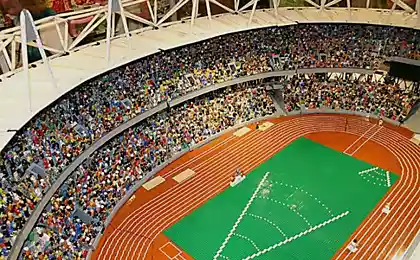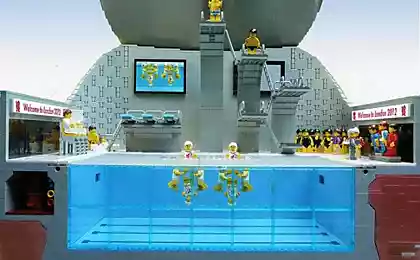975
For that shot the designer Taubina (16 photos)
In this article you can think about to introduce the conditions in which the atmosphere in which the designers worked in particular military technology at the time. I was struck this information is not known to a wider audience and is quite interesting, let's honor ...
In the history of the domestic arms industry Ya.G.Taubin known as the man for many decades ahead of its time: under his leadership was established the world's first infantry automatic grenade launcher. And this is the designer became the sole head of CB weapons, which was shot on the standard charges of sabotage.
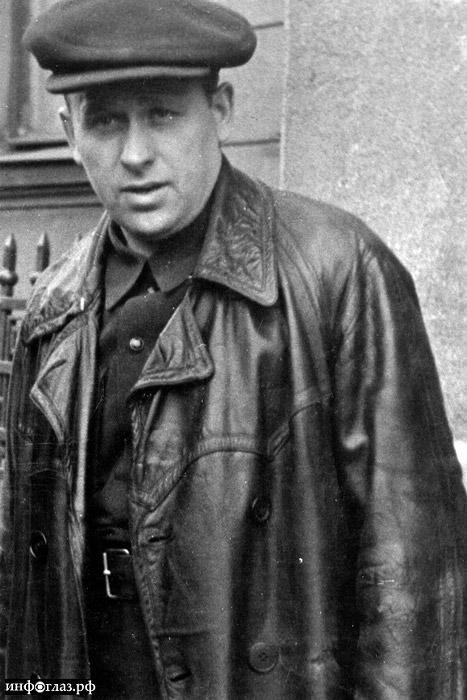
first development design bureau under the guidance of YG Taubina (CBT later OKB-16 in Moscow) became 40, 8 mm automatic grenade-Taubina-Baburin AG-TB.
40, 8 mm automatic grenade launcher Taubina was a formidable weapon. Rate of fire was 440-460 rounds per minute. Another issue that the shop Dining practical rate initially not more than 50-60 rounds per minute.

40, 8 mm automatic grenade-Taubina-Baburin AG-TB
But Taubina version was developed and ribbon supplies. This practical rate becomes equal to the rate of fire. Given the small charge of a unitary cartridge barrel heating and wear when shooting were small. Thus, the tape length dependent on weight. Practical shooting grenade was the distance of 1200 m.
Grenade had rifled barrel. In most embodiments - 18 grooves. Automatic grenade launcher was originally worked by gases from the barrel. But to increase the reliability of a grenade in 1936 introduced a new scheme of automation, which has worked with energy rollback barrel when a long course.
By 40, 8 mm grenade launcher was originally adopted tripod machine, and then - a light wheeled machine, similar in design to the machine 7, 62-mm machine gun "Maxim". In winter, the installation put on skis. The grenade launcher can be easily disassembled and transferred manually to the battlefield.
The first grenade launchers manufactured weighing 73 kg, but after the modernization of the machine and its weight was reduced to 45, 5 kg, and in 1939 the weight of the grenade launcher was brought to 38 kg. Moreover, weight reduction was carried out without deterioration of firepower.
Already on the results of the military trials end in 1937 grenade should adopt the Red Army. All the deficiencies noted were not material and disposable. No shortcomings have not been taken into service, no artillery system. How many shortcomings had 76-mm divisional cannon F-22 (mod. 1936), and because it allowed into mass production. What happened?
The fact that Taubin crossed the road "mortar." They found that the grenade Taubina casts doubt on the continuation of the 50-mm mortar company commander, and maybe even 60-mm and 82-mm mortars.
Taubin wrote in the People's Commissariat of Defense: "Individual workers Artkoma Dorovlev, Bogomolov, Bulba, Ignatenko throughout 1937 with the help of the former chairman of the Artillery Committee AU-Kirillov Gubetskogo created an atmosphere of intimidation around ... 40, 8 mm grenade».

Top five grenades 40, 8 mm grenade
"Mortar" managed to exit the Defense Committee decision number 137 of 22 June 1938, on the basis of which was adopted by the 50-mm mortar shells, which had many design flaws.
"Mortar" sought by Artupravleniya fantastic stupidity solutions - 40 testing, 8 mm grenade launcher with 50-mm mortar firing mortar rounds on the program. Naturally, the mortar could not keep grazing fire. It is not included in the program. Grenade could effectively conduct both grazing and fire curtain. But at the maximum angle of elevation accuracy of firing 50-mm mortar shell was slightly better. In addition, the mortar was much easier and cheaper grenade.
Cost grenade was relatively large because it was produced by semi-artisan in OKB-16. After launching a grenade into mass production the cost would be significantly reduced. Naturally, with "childhood diseases" grenade-type weakness springs receiver, extractor and ejector in series production would be done away with. So, incidentally, it was the other weapon systems.
But alas, the "mortar" won. 50 mm mortar was put into mass production. Since the beginning of the Great Patriotic War 50-mm mortar has proved to be insufficiently effective weapon, and was taken out of production and weapons.
Grenade adopted is not accepted, but the trial continued. In January 1940, several grenade Taubina participated in the battles on the Karelian Isthmus. Even in the 40-degree cold automatic grenade launchers operated flawlessly.
In Taubina dropped his hands in the fight against such a powerful opponent.
The project is shut down, but the country's leaders noticed a talented gunsmith. So when in early 1938, a new 23-mm cartridge with a high muzzle velocity of 900 m / s, the development of the aircraft automatic gun under it instructed the OKB-16. In parallel, the same task was Tula CDB-14.
The OKB-16 work on a 23-mm automatic cannon headed leading designer MN Baburin, his group consisted of AE Nudelman, A. S.Suranov, V.L.Taubkin, PI fungus and others. The general management of the work carried out YG Taubin. The basis of the design of the gun lay automatic grenade launcher, which helped design it fast enough.
Motor-gun, ie designed for installation in the collapse of the engine cooling water has received factory designation MP-3. She worked on the principle of the recoil of the barrel when it is a long course, Stock is made from mechanized store with 81 cartridge. The cartridges were filled with clips in 9 to 9 rounds in each of which, as an expenditure, replaced by new ones with a special drive. A feature of the system was a low rate of fire - 300 rds. / Min.

Michael Nikitich Baburin, deputy chief designer of OKB-16 Ya.G.Taubina
But the Air Force demanded rate of 600 rds. / Min, and an improved gun, which had the desired rate of fire, received the designation MP-6. She had a small weight (about 70 kg) and has a compact that has attracted of aircraft, expects to equip their new machines with powerful and light guns Taubina.
Meanwhile, at the beginning of 1940 in CDB-14 were prepared 23-mm cannon designs and Salishcheva Galkina (SG) and Volkov and Yartsev (VIA). These guns were automatic with the removal of powder gases and tape food, the rate of fire of about 550-650 rds. / Min.

Aviation gun MP-6
In October 1940 gun MP-6 entered the field tests in NII VVS AB (Noginsk), where it was established on the German plane "Messerschmitt-110." MP-6 was tested in parallel with the load cell vapor gun. Dignity shop Dining gun MP-6 polygon considered not obvious for many reasons. What is very important - to set the MP-6 in the wing required cover its special fairing worsening aerodynamics. And if for weight and size characteristics of MP-6 and load cells were comparable, then the reliability and survivability advantage was on the side of the load cells (0, 05% of delays and 0, 1% damage in comparison to 0, 21% / 0, 62% for MP -6), and most importantly - Shop powered MP-6 completely no good, it needed reworking under the tape.

Aviation gun VYa
The test cycle MP-6 has not yet been completed (it is not passed on fire survivability in the amount of 10 000 rds.), The results for a number of items alarming when the decree №423ss Defense Committee on 16 November 1940 it adopted a Red Army Air Force . And on November 20 for the development of cannon and his deputy Ya.G.Taubin M.N.Baburin he was awarded the Order of Lenin - the highest award of the Soviet Union.
But the polygon considered appropriate to allow the gun to load cells flight tests after the flight test MP-6. That is, the product of Tula putting the fate of their products depending on the MP-6. It did not suit Volkov and Yartsev and they November 30, 1940 wrote a letter to Stalin outlining his vision of progress and results of the tests. From a letter Volkov and Yartsev leadership learned that the Air Force, in any case, already have a spare gun!
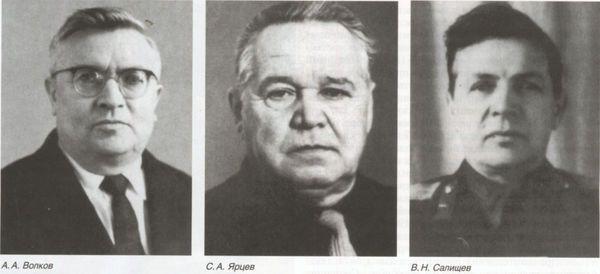
But the October 4, 1940 SNK and the Central Committee of the CPSU (b) of the "On the production of prototypes of weapons for NGOs" OKB-16 was mandated to develop the aviation AP-12 machine gun, machine gun 7. Period for installed hard - no later than December 25, he should enter the field tests. Requirements to become a machine gun under the terms were - for combat characteristics it should not yield to 12, 7-mm machine gun Berezina, but weigh half as much, and survivability have twice as much! Compliance with these terms and level of development, even now it is extremely difficult, but then maybe it was substantially less.
Almost in the same period Taubin taken for the design of the aircraft 37-mm automatic cannon. But the two are under development guns Ya.G.Taubinu not enough. Since 1939, he strongly suggested SAU to develop 23-mm anti-aircraft guns with MP-3. And got his work was authorized. However, anti-aircraft guns need land carriages, and experience their creation at OKB-16 was not. Work on anti-aircraft guns went slowly and gradually Taubin abandoned anti-aircraft guns.
From that moment began the difficulties which led to the Ya G.Taubina sad finale.

Since November 1940 started the process of serial production guns MT-6. The gun was taken into service with magazine-fed, but from the outset it was clear that it needed the power transfer to tape. Strange situation: the plants are beginning to master the production of guns with the store, and in parallel with that from the middle of December 1940 the OKB-16 in an emergency procedure modifies the gun under the tape. In this paper, on the one hand Taubina "customized" Commissar B.L.Vannikov weapons, on the other - Designer stormtrooper SB-2 (CDB-55) Ilyushin needing refinement place for guns in the wing of the aircraft.
In mid-October 1940, SV Ilyushin Taubina requested the return value of the efforts of his gun to his account of the design of the SB-2 attack aircraft. Taubin said the MP-6 is the return of 2,200 kgs. But held in TsAGI studies have shown that its value is more than 2 times greater than the stated Taubina. From 10 to 22 January, a comparative test guns load cells and MP-6 with two belt-fed SB-2, and both of them successfully passed cannon. Although the load cell has a value of return of about 4000 kg, Ilyushin chose for his stormtrooper was it like more spent. The temporary solution was found quickly - January 17 order was issued NCAP №147 «On arming the IL-2" define: the standard-attack aircraft should be installed less powerful, but reliable 20-mm cannon ShVAK.
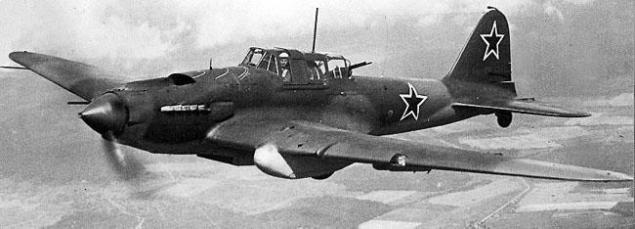
CDB-55 attack aircraft Ilyushin design, the progenitor of the IL-2
The story of the return of MP-6, which became known in high places looked like that Taubin cheated of aircraft and jeopardize the launch of a series of new combat aircraft and even the safety of their operation. That alone was enough for rigorous proceedings with unpredictable consequences. But this willingly or unwillingly "puncture" YG Taubina was not the last.
Gun MP-6 was installed on the fighter LaGG-3. By the spring of 1941 it became clear that because of the significant impact of MP-6 in place of its connection to the engine M-105P cracks, and the gun can be used only if the strengthening of its housing. There was a failure of the task of modern fighters armed with guns. At the time, it was ranked as a clear sabotage.

Fighter LaGG-3 (designers Lavochkin, V.P.Gorbunov, M.I.Gudkov)
Then the People's Commissar of Aircraft Industry AI Shakhurin to save the situation, went to the arbitrariness - allow the production of M-105P engine with a reinforced crankcase, without coordinating the move with the Government, the CPC and the CPSU (b). When information about the arbitrariness Shakhurin reached Stalin, are intolerant to violations of the rules, followed by immediate punishment. Decision of the CPC and the CPSU (b) on March 4, 1941 AI Shakhurin was charged in an inconsistent weighting motor M-105 with a view to its adaptation to the gun Taubina and warned that in the future for such actions will be followed by a more severe penalty. But the "victim", brought by Shakhurin, was in vain - April 12 during the regular testing LaGG-3 with a reinforced crankcase engine and MP-6 - Mount the gun was again thwarted impact ...

Alexey Shakhurin
During these tests, the MP-6 from the first production batch plant №66 proved extremely unreliable - delays occurred an average of one to 15 shots (at the gun ShVAK - a delay of 220 rds.), Often had a breakdown. Tested simultaneously with the MP-6 on the same fighter gun load cells and SG also acted "not ah" - there were many delays, breakdowns and even some cases shot at unlocked the barrel, but the position of these guns, compared to taubinskoy, no particular alarm. After all, they were experienced, and the MP-6 is the serial!
While in March 1941 the designers of OKB-16 "licked" gun MP-6, the leadership of the IEC became clear that the development of production of MP-6 goes bad. In the Tula factory tests and carpets often had breakdowns and that critical mass cases of shots in the unlocked bore. Whatever was the reason to release a series suitable for delivery to the aircraft factories guns worked. And in this situation Taubin is preparing a new version of the MP-6 with belt-fed, which means for the plants in the short term breaking organized labor to manufacture guns with magazine-fed! As a result, the MP-6 was removed from the production and work on it stopped. This failure in the OKB-16 and personally Ya.G.Taubina could not lead to his tragic consequences - of this unfortunate precedent progress development of weapons were.

Modifications aircraft machine gun UB (Universal Berezin)
The biggest repercussions Taubina work on 12, 7 mm machine gun aviation AP-12, 7. November 4, 1940 due to extreme stress bureaus and stop work on the cannon prototype AP-12, 7 turret version was ready. He was automatic, functioning at the expense of short stroke barrel, magazine-fed, and weighs only 12, 5 kg. With time to spare before the trials began Taubin processing machine gun under the tape DSHK (later revealed an unfortunate choice of tapes - aircraft designers insisted on the loose tape machine gun UB). AP-12 machine gun, 7 showed the Air Force divinzheneru I.Sakrieru (he was subsequently shot with Taubina). Without ground tests Sakrier reported on the readiness of weapons at the State Air Force, where this information is left to the leadership of the country. In fact, the machine gun was designed so that the failure of the after 150-200 shots.
But in late November and early December 1940 the IEC has started preparation of the AP-12, 7 to launch series of aircraft are required to include a machine gun in advanced aircraft weapon systems. "Wake-up call" for the AP-12, 7 rang in the end of December 1940, when he had not entered the field tests. Meanwhile, by 10 January plants almost completed the development of technology of machine guns, and the factory №74 even released a few test samples.

Aviation gun AP-12, 7 designs of OKB-16
The situation is readily AP-12 machine guns, 7 for mass production in the factory №74 described his former director, later - Deputy IEC V.N.Novikov. "... Designer Taubin managed to visit the reception at Malenkov, Stalin then and a lot of it has promised. Like, Designer Berezin, Shpitalnaya Volkov Yartsev trying to create a new machine gun. But I'll make a gun 2 times more than double the rate of fire and easier than they do. [...] Malenkov and Stalin believed Taubina. Last month, 7-8. Vannikov dragged me to the factory and forced to do this Taubina gun. Our gun was completely raw. Only then I confessed Nudelman - Deputy Taubina that he was not even made in a wooden mockup. Just prepare drawings and put the plant. And I wondered why not go the designer, what is it? I came to the factory Vannikov [...], Deputy Chief of the Air Force General Sakrier. With them, I had to shoot this gun Taubina. I machine guns shot out of 5 of 5 pieces, all of them worked. [...] At the second stage, all these guns collapsed. Literally everything. One gate, another latch, etc. [...] ».
Started friend of MP-6 History - OKB-16 machine gun was in the process of modifying the organization of its production, introducing significant changes in the design of many parts and assemblies. As a result, within the prescribed period the production of PA-12, 7, has not begun. And the beginning of production of the gun MP-6, which also should have been held in January-February 1941, was also disrupted. For information about this, now the second failure Taubina, brought to the country's leadership. The designer went to meet him. Deadline for submission of guns to the test changed.
In the history of the domestic arms industry Ya.G.Taubin known as the man for many decades ahead of its time: under his leadership was established the world's first infantry automatic grenade launcher. And this is the designer became the sole head of CB weapons, which was shot on the standard charges of sabotage.

first development design bureau under the guidance of YG Taubina (CBT later OKB-16 in Moscow) became 40, 8 mm automatic grenade-Taubina-Baburin AG-TB.
40, 8 mm automatic grenade launcher Taubina was a formidable weapon. Rate of fire was 440-460 rounds per minute. Another issue that the shop Dining practical rate initially not more than 50-60 rounds per minute.

40, 8 mm automatic grenade-Taubina-Baburin AG-TB
But Taubina version was developed and ribbon supplies. This practical rate becomes equal to the rate of fire. Given the small charge of a unitary cartridge barrel heating and wear when shooting were small. Thus, the tape length dependent on weight. Practical shooting grenade was the distance of 1200 m.
Grenade had rifled barrel. In most embodiments - 18 grooves. Automatic grenade launcher was originally worked by gases from the barrel. But to increase the reliability of a grenade in 1936 introduced a new scheme of automation, which has worked with energy rollback barrel when a long course.
By 40, 8 mm grenade launcher was originally adopted tripod machine, and then - a light wheeled machine, similar in design to the machine 7, 62-mm machine gun "Maxim". In winter, the installation put on skis. The grenade launcher can be easily disassembled and transferred manually to the battlefield.
The first grenade launchers manufactured weighing 73 kg, but after the modernization of the machine and its weight was reduced to 45, 5 kg, and in 1939 the weight of the grenade launcher was brought to 38 kg. Moreover, weight reduction was carried out without deterioration of firepower.
Already on the results of the military trials end in 1937 grenade should adopt the Red Army. All the deficiencies noted were not material and disposable. No shortcomings have not been taken into service, no artillery system. How many shortcomings had 76-mm divisional cannon F-22 (mod. 1936), and because it allowed into mass production. What happened?
The fact that Taubin crossed the road "mortar." They found that the grenade Taubina casts doubt on the continuation of the 50-mm mortar company commander, and maybe even 60-mm and 82-mm mortars.
Taubin wrote in the People's Commissariat of Defense: "Individual workers Artkoma Dorovlev, Bogomolov, Bulba, Ignatenko throughout 1937 with the help of the former chairman of the Artillery Committee AU-Kirillov Gubetskogo created an atmosphere of intimidation around ... 40, 8 mm grenade».

Top five grenades 40, 8 mm grenade
"Mortar" managed to exit the Defense Committee decision number 137 of 22 June 1938, on the basis of which was adopted by the 50-mm mortar shells, which had many design flaws.
"Mortar" sought by Artupravleniya fantastic stupidity solutions - 40 testing, 8 mm grenade launcher with 50-mm mortar firing mortar rounds on the program. Naturally, the mortar could not keep grazing fire. It is not included in the program. Grenade could effectively conduct both grazing and fire curtain. But at the maximum angle of elevation accuracy of firing 50-mm mortar shell was slightly better. In addition, the mortar was much easier and cheaper grenade.
Cost grenade was relatively large because it was produced by semi-artisan in OKB-16. After launching a grenade into mass production the cost would be significantly reduced. Naturally, with "childhood diseases" grenade-type weakness springs receiver, extractor and ejector in series production would be done away with. So, incidentally, it was the other weapon systems.
But alas, the "mortar" won. 50 mm mortar was put into mass production. Since the beginning of the Great Patriotic War 50-mm mortar has proved to be insufficiently effective weapon, and was taken out of production and weapons.
Grenade adopted is not accepted, but the trial continued. In January 1940, several grenade Taubina participated in the battles on the Karelian Isthmus. Even in the 40-degree cold automatic grenade launchers operated flawlessly.
In Taubina dropped his hands in the fight against such a powerful opponent.
The project is shut down, but the country's leaders noticed a talented gunsmith. So when in early 1938, a new 23-mm cartridge with a high muzzle velocity of 900 m / s, the development of the aircraft automatic gun under it instructed the OKB-16. In parallel, the same task was Tula CDB-14.
The OKB-16 work on a 23-mm automatic cannon headed leading designer MN Baburin, his group consisted of AE Nudelman, A. S.Suranov, V.L.Taubkin, PI fungus and others. The general management of the work carried out YG Taubin. The basis of the design of the gun lay automatic grenade launcher, which helped design it fast enough.
Motor-gun, ie designed for installation in the collapse of the engine cooling water has received factory designation MP-3. She worked on the principle of the recoil of the barrel when it is a long course, Stock is made from mechanized store with 81 cartridge. The cartridges were filled with clips in 9 to 9 rounds in each of which, as an expenditure, replaced by new ones with a special drive. A feature of the system was a low rate of fire - 300 rds. / Min.

Michael Nikitich Baburin, deputy chief designer of OKB-16 Ya.G.Taubina
But the Air Force demanded rate of 600 rds. / Min, and an improved gun, which had the desired rate of fire, received the designation MP-6. She had a small weight (about 70 kg) and has a compact that has attracted of aircraft, expects to equip their new machines with powerful and light guns Taubina.
Meanwhile, at the beginning of 1940 in CDB-14 were prepared 23-mm cannon designs and Salishcheva Galkina (SG) and Volkov and Yartsev (VIA). These guns were automatic with the removal of powder gases and tape food, the rate of fire of about 550-650 rds. / Min.

Aviation gun MP-6
In October 1940 gun MP-6 entered the field tests in NII VVS AB (Noginsk), where it was established on the German plane "Messerschmitt-110." MP-6 was tested in parallel with the load cell vapor gun. Dignity shop Dining gun MP-6 polygon considered not obvious for many reasons. What is very important - to set the MP-6 in the wing required cover its special fairing worsening aerodynamics. And if for weight and size characteristics of MP-6 and load cells were comparable, then the reliability and survivability advantage was on the side of the load cells (0, 05% of delays and 0, 1% damage in comparison to 0, 21% / 0, 62% for MP -6), and most importantly - Shop powered MP-6 completely no good, it needed reworking under the tape.

Aviation gun VYa
The test cycle MP-6 has not yet been completed (it is not passed on fire survivability in the amount of 10 000 rds.), The results for a number of items alarming when the decree №423ss Defense Committee on 16 November 1940 it adopted a Red Army Air Force . And on November 20 for the development of cannon and his deputy Ya.G.Taubin M.N.Baburin he was awarded the Order of Lenin - the highest award of the Soviet Union.
But the polygon considered appropriate to allow the gun to load cells flight tests after the flight test MP-6. That is, the product of Tula putting the fate of their products depending on the MP-6. It did not suit Volkov and Yartsev and they November 30, 1940 wrote a letter to Stalin outlining his vision of progress and results of the tests. From a letter Volkov and Yartsev leadership learned that the Air Force, in any case, already have a spare gun!

But the October 4, 1940 SNK and the Central Committee of the CPSU (b) of the "On the production of prototypes of weapons for NGOs" OKB-16 was mandated to develop the aviation AP-12 machine gun, machine gun 7. Period for installed hard - no later than December 25, he should enter the field tests. Requirements to become a machine gun under the terms were - for combat characteristics it should not yield to 12, 7-mm machine gun Berezina, but weigh half as much, and survivability have twice as much! Compliance with these terms and level of development, even now it is extremely difficult, but then maybe it was substantially less.
Almost in the same period Taubin taken for the design of the aircraft 37-mm automatic cannon. But the two are under development guns Ya.G.Taubinu not enough. Since 1939, he strongly suggested SAU to develop 23-mm anti-aircraft guns with MP-3. And got his work was authorized. However, anti-aircraft guns need land carriages, and experience their creation at OKB-16 was not. Work on anti-aircraft guns went slowly and gradually Taubin abandoned anti-aircraft guns.
From that moment began the difficulties which led to the Ya G.Taubina sad finale.

Since November 1940 started the process of serial production guns MT-6. The gun was taken into service with magazine-fed, but from the outset it was clear that it needed the power transfer to tape. Strange situation: the plants are beginning to master the production of guns with the store, and in parallel with that from the middle of December 1940 the OKB-16 in an emergency procedure modifies the gun under the tape. In this paper, on the one hand Taubina "customized" Commissar B.L.Vannikov weapons, on the other - Designer stormtrooper SB-2 (CDB-55) Ilyushin needing refinement place for guns in the wing of the aircraft.
In mid-October 1940, SV Ilyushin Taubina requested the return value of the efforts of his gun to his account of the design of the SB-2 attack aircraft. Taubin said the MP-6 is the return of 2,200 kgs. But held in TsAGI studies have shown that its value is more than 2 times greater than the stated Taubina. From 10 to 22 January, a comparative test guns load cells and MP-6 with two belt-fed SB-2, and both of them successfully passed cannon. Although the load cell has a value of return of about 4000 kg, Ilyushin chose for his stormtrooper was it like more spent. The temporary solution was found quickly - January 17 order was issued NCAP №147 «On arming the IL-2" define: the standard-attack aircraft should be installed less powerful, but reliable 20-mm cannon ShVAK.

CDB-55 attack aircraft Ilyushin design, the progenitor of the IL-2
The story of the return of MP-6, which became known in high places looked like that Taubin cheated of aircraft and jeopardize the launch of a series of new combat aircraft and even the safety of their operation. That alone was enough for rigorous proceedings with unpredictable consequences. But this willingly or unwillingly "puncture" YG Taubina was not the last.
Gun MP-6 was installed on the fighter LaGG-3. By the spring of 1941 it became clear that because of the significant impact of MP-6 in place of its connection to the engine M-105P cracks, and the gun can be used only if the strengthening of its housing. There was a failure of the task of modern fighters armed with guns. At the time, it was ranked as a clear sabotage.

Fighter LaGG-3 (designers Lavochkin, V.P.Gorbunov, M.I.Gudkov)
Then the People's Commissar of Aircraft Industry AI Shakhurin to save the situation, went to the arbitrariness - allow the production of M-105P engine with a reinforced crankcase, without coordinating the move with the Government, the CPC and the CPSU (b). When information about the arbitrariness Shakhurin reached Stalin, are intolerant to violations of the rules, followed by immediate punishment. Decision of the CPC and the CPSU (b) on March 4, 1941 AI Shakhurin was charged in an inconsistent weighting motor M-105 with a view to its adaptation to the gun Taubina and warned that in the future for such actions will be followed by a more severe penalty. But the "victim", brought by Shakhurin, was in vain - April 12 during the regular testing LaGG-3 with a reinforced crankcase engine and MP-6 - Mount the gun was again thwarted impact ...

Alexey Shakhurin
During these tests, the MP-6 from the first production batch plant №66 proved extremely unreliable - delays occurred an average of one to 15 shots (at the gun ShVAK - a delay of 220 rds.), Often had a breakdown. Tested simultaneously with the MP-6 on the same fighter gun load cells and SG also acted "not ah" - there were many delays, breakdowns and even some cases shot at unlocked the barrel, but the position of these guns, compared to taubinskoy, no particular alarm. After all, they were experienced, and the MP-6 is the serial!
While in March 1941 the designers of OKB-16 "licked" gun MP-6, the leadership of the IEC became clear that the development of production of MP-6 goes bad. In the Tula factory tests and carpets often had breakdowns and that critical mass cases of shots in the unlocked bore. Whatever was the reason to release a series suitable for delivery to the aircraft factories guns worked. And in this situation Taubin is preparing a new version of the MP-6 with belt-fed, which means for the plants in the short term breaking organized labor to manufacture guns with magazine-fed! As a result, the MP-6 was removed from the production and work on it stopped. This failure in the OKB-16 and personally Ya.G.Taubina could not lead to his tragic consequences - of this unfortunate precedent progress development of weapons were.

Modifications aircraft machine gun UB (Universal Berezin)
The biggest repercussions Taubina work on 12, 7 mm machine gun aviation AP-12, 7. November 4, 1940 due to extreme stress bureaus and stop work on the cannon prototype AP-12, 7 turret version was ready. He was automatic, functioning at the expense of short stroke barrel, magazine-fed, and weighs only 12, 5 kg. With time to spare before the trials began Taubin processing machine gun under the tape DSHK (later revealed an unfortunate choice of tapes - aircraft designers insisted on the loose tape machine gun UB). AP-12 machine gun, 7 showed the Air Force divinzheneru I.Sakrieru (he was subsequently shot with Taubina). Without ground tests Sakrier reported on the readiness of weapons at the State Air Force, where this information is left to the leadership of the country. In fact, the machine gun was designed so that the failure of the after 150-200 shots.
But in late November and early December 1940 the IEC has started preparation of the AP-12, 7 to launch series of aircraft are required to include a machine gun in advanced aircraft weapon systems. "Wake-up call" for the AP-12, 7 rang in the end of December 1940, when he had not entered the field tests. Meanwhile, by 10 January plants almost completed the development of technology of machine guns, and the factory №74 even released a few test samples.

Aviation gun AP-12, 7 designs of OKB-16
The situation is readily AP-12 machine guns, 7 for mass production in the factory №74 described his former director, later - Deputy IEC V.N.Novikov. "... Designer Taubin managed to visit the reception at Malenkov, Stalin then and a lot of it has promised. Like, Designer Berezin, Shpitalnaya Volkov Yartsev trying to create a new machine gun. But I'll make a gun 2 times more than double the rate of fire and easier than they do. [...] Malenkov and Stalin believed Taubina. Last month, 7-8. Vannikov dragged me to the factory and forced to do this Taubina gun. Our gun was completely raw. Only then I confessed Nudelman - Deputy Taubina that he was not even made in a wooden mockup. Just prepare drawings and put the plant. And I wondered why not go the designer, what is it? I came to the factory Vannikov [...], Deputy Chief of the Air Force General Sakrier. With them, I had to shoot this gun Taubina. I machine guns shot out of 5 of 5 pieces, all of them worked. [...] At the second stage, all these guns collapsed. Literally everything. One gate, another latch, etc. [...] ».
Started friend of MP-6 History - OKB-16 machine gun was in the process of modifying the organization of its production, introducing significant changes in the design of many parts and assemblies. As a result, within the prescribed period the production of PA-12, 7, has not begun. And the beginning of production of the gun MP-6, which also should have been held in January-February 1941, was also disrupted. For information about this, now the second failure Taubina, brought to the country's leadership. The designer went to meet him. Deadline for submission of guns to the test changed.















